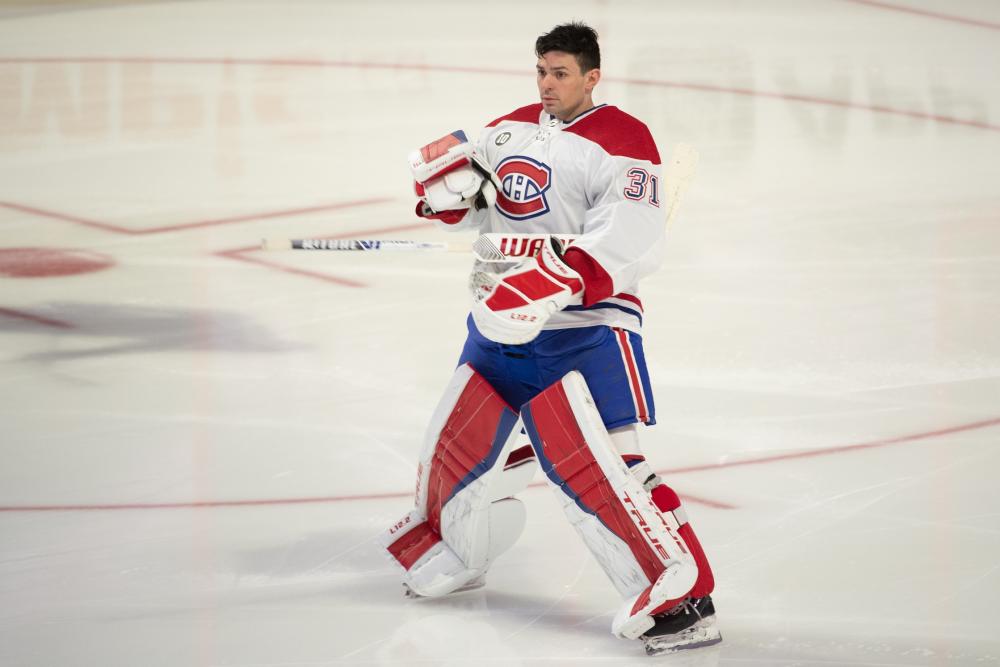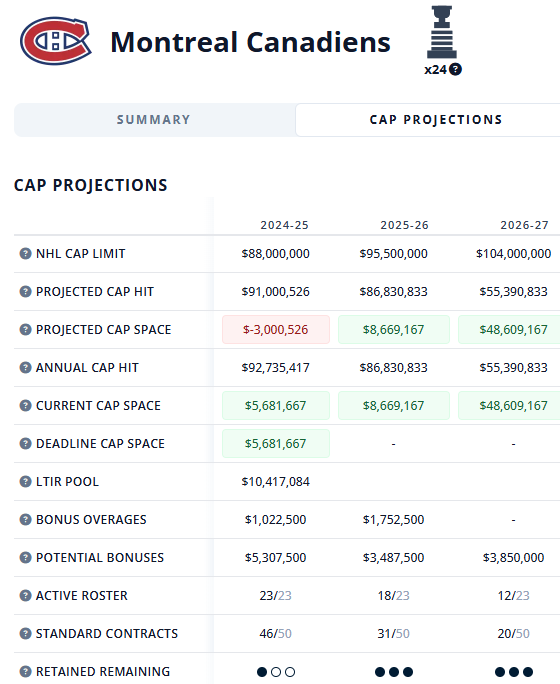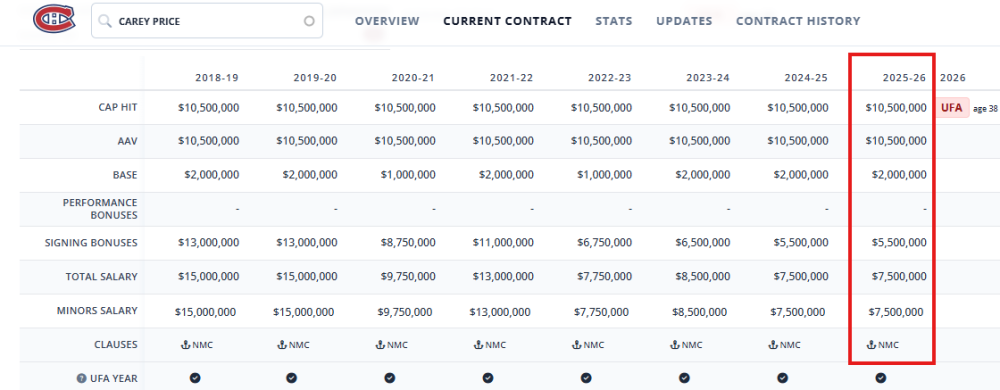NHL News
Montreal’s Cap Situation Could Block Big Moves—Unless They Trade Carey Price

Special for PuckPedia by Marco D'Amico, Senior News Editor at RG Media. Image © Marc DesRosiers-Imagn Images
The Montreal Canadiens will look to be very active on the trade front this summer, while not opposing the idea of spending on the short-term to help their team reach another level next season.
Having narrowly made the playoffs during the 2024-2025 season, the Canadiens have identified clear needs: A #2 center and another right-shot defenseman.
But there seems to be a bit of an issue.
Canadiens GM Kent Hughes is very open to adding to his roster, rather than making lateral trades. However, the Habs are working with limited resources at the moment.
Thanks to a $1.75M bonus overage penalty, the Canadiens only have about $8.7M in cap space for next season.
If the Canadiens were to play their cards right, that could potentially become $19.2M in cap space by putting Carey Price’s contract on Long-Term Injury Reserve (LTIR).
This while also having to extend RFAs like Emil Heineman and Jayden Struble, who likely cost them a combined $2M-$3M. That’s not much room to add a player or two that could impact the roster.
The Canadiens have utilized LTIR over the last four years in order to spend above the salary cap thanks to Carey Price’s $10.5M Cap Hit contract, but that may become problematic next season.

2025-2026 Outlook
The Montreal Canadiens find themselves in a predicament.
On the one side, they want to start reaching the playoffs consistently and building a winner. But, on the other end, they want to stop needing the use of LTIR to field a roster.
Using LTIR for the 2025-2026 season could complicate things for the Canadiens.
Once a player is placed on Long-Term Injured Reserve (LTIR), a team can exceed the salary cap. At the same time, teams must also plan around performance overage bonuses—extra payments to players, usually on entry-level deals or over-35 contracts, who hit certain performance benchmarks like goals, points, or league awards. These bonuses count against the cap, and if they push a team over the limit or said team is already using LTIR, the excess becomes a cap overage penalty cap hit applied to the following season.
Balancing LTIR relief and potential bonus overages is already a challenge for any cap-tight team, but things get even trickier for the Canadiens with the arrival of top-end prospects like Ivan Demidov and, to a lesser extent, Oliver Kapanen. Add in Lane Hutson and David Reinbacher, and the stakes get even higher.
Hutson looks like a real contender for the Calder Trophy this season, and Demidov is already drawing attention as a favorite for next year. If those bonuses hit, they’ll roll over into next season’s cap, making every dollar count even more in the team’s roster planning.
Demidov currently has a potential bonus output of $2M next season with the Canadiens, and, given how strong of a player he is, there’s a chance he notches a good amount of that total.
“There’s a very good chance that Ivan Demidov is in the running for the Calder trophy next season, especially if he continues to play on Montreal top unit,” said an NHL executive on the subject. “I don’t know how his contract is structured, but I can see him hitting many bonuses by this time next year.”
Then you have Oliver Kapanen, whose agent Simo Niiranen purposefully avoided adding any performance bonuses in the first year of his contract, while he was in Sweden, in order to fill years two and three of his ELC with bonuses. He stands to potentially earn up to $637,500 in bonuses next season as well.
Then there’s Lane Hutson, who maxed out his bonus payments for the 24-25 season at $750,000 after a terrific season. Hutson’s contract stipulates he can only earn a maximum of $1.15M in bonuses over the final two years of his contract, meaning he can still earn $400,000 during the 25-26 season; and, unless something goes wrong, it’s very likely he nets the maximum.
And then there’s David Reinbacher, whom the Canadiens brass believe could be ready for some regular minutes in the NHL after a good showing in the AHL Playoffs. Reinbacher’s contract offers him the potential to add up to $1M in performance bonuses as well.
“I wouldn’t discount the possibility of David Reinbacher spending a good portion of the year with the Canadiens next season,” said a pro scout on Reinbacher’s NHL-readiness.
For those counting, that’s $4.04M in potential performance bonuses that the Canadiens could have next year. It doesn’t seem like much now, as the salary cap continues to rise year-over-year, but it would significantly hurt the team during the summer of 2026, when they’ll be looking to start contending and have to re-sign Lane Hutson.
The Solution: Carey Price
Carey Price’s contract has kind of been the elephant in the room for the Montreal Canadiens ever since he announced that his playing career was over, back in the Spring of 2022.
His gargantuan $10.5M cap hit made it virtually impossible for the Canadiens to work around without needing to place his contract on LTIR for the last three seasons.
The problem with that? The Canadiens have been icing young teams filled with players on entry-level contracts who partially or mostly hit their performance bonuses, resulting in yearly overage penalties.
However, the Canadiens will only be on the hook for one more season (25-26) before Price’s contract is set to expire, with his $5.5M signing bonus paid out on Sept 1.
With the Canadiens looking to take the next step in this rebuild, they’ll want to spend more than just $4-6M to improve the team, and the best way to do so is to convince a team looking to hit the salary cap floor to take on Price’s contract.
“Price’s contract is a big anchor for the Canadiens right now, and if they want to gain that full flexibility, they’ll be wise to move it,” said another NHL executive.
With only $2M in actual salary to pay out, almost all of which is covered by insurance at this point, lower spending teams looking to reduce costs could easily find Carey Price’s contract attractive.

“With the salary cap increasing in such a big way, some teams way want to cover their bases by acquiring a contract like that, just like Chicago just did with Shea Weber,” added the source.
Teams will have to spend $70.6M next season to reach the salary cap floor, an increase of $5.6M from the 2024-2025 season, and acquiring Price’s contract on the cheap could be an easy way for them to reach the floor without having to spend any actual money.
We’ve seen teams utilize this strategy in the past, like the Chicago Blackhawks and the Arizona Coyotes with the acquisitions of Shea Weber’s contract; and Price’s last remaining year could provide that no-risk buffer to allow teams to keep spending low as they rebuild or focus on developing their youth.
On the flipside, the Canadiens would be able to utilize the newfound $10.5M in cap space, for a total $19.2M, to bring in an impact player or two via trade or free agency in order to truly push the team to another level.
It’ll be a hot topic to watch this summer, with sources across the league noting the chatter around the Canadiens’ desire to be aggressive.
Marco D'Amico is the Senior News Editor at RG Media, where he serves as a beat reporter covering the Montreal Canadiens and the NHL Draft. Known for his in-depth analysis of NHL CBA intricacies and prospect development, he is also a regular guest on TSN690 and BPM Sports.







